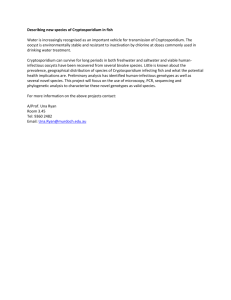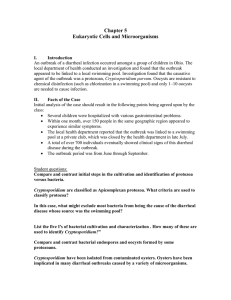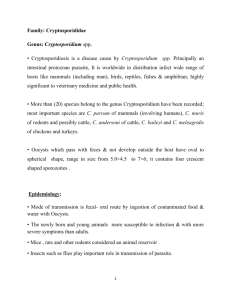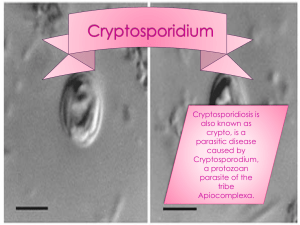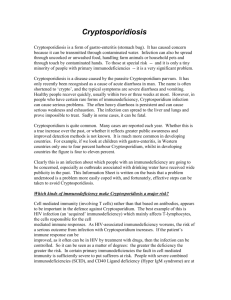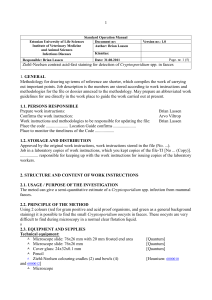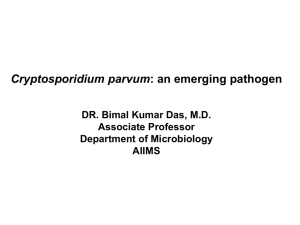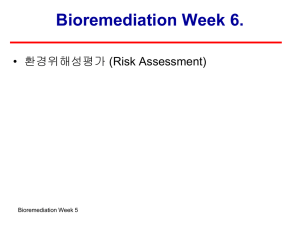U.S. EPA and DHS Center of Excellence
advertisement
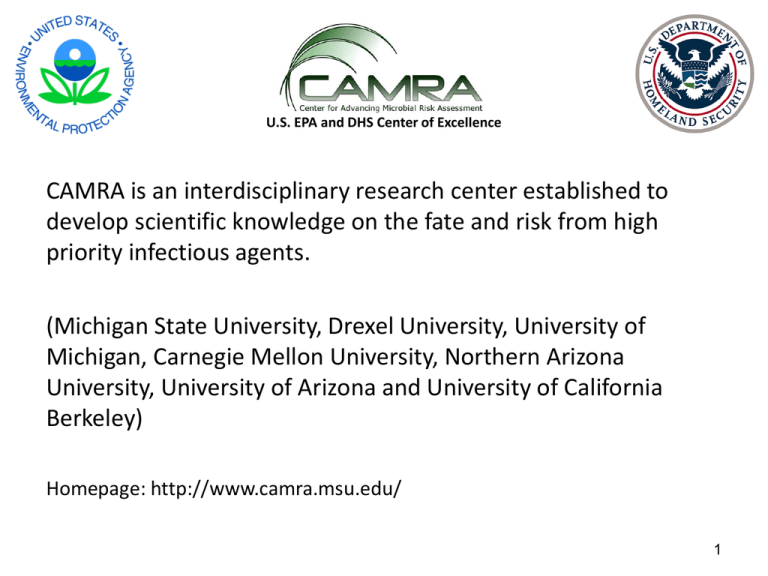
U.S. EPA and DHS Center of Excellence
CAMRA is an interdisciplinary research center established to
develop scientific knowledge on the fate and risk from high
priority infectious agents.
(Michigan State University, Drexel University, University of
Michigan, Carnegie Mellon University, Northern Arizona
University, University of Arizona and University of California
Berkeley)
Homepage: http://www.camra.msu.edu/
1
Introduction to Quantitative
Microbial Risk Assessment
Joan B. Rose, Ph.D., Yin Huang, Ph.D.
Michigan State University
2
Quantitative Microbial Risk
Assessment (QMRA)
• What is QMRA?
A method for assessing risks from microbial agents in
a framework that defines the statistical probability of
an infection from the environmental pollution of
water, soil, food, surfaces and hands
• Problem formulation
The problem should be formulated to respond
directly to the needs of decision makers,
stakeholders, as well as the interested public, and to
guide the risk assessment paradigm
3
Risk Assessment Paradigm
HAZARD IDENTIFICATION
Types of microorganisms and disease
end-points
DOSE-RESPONSE
Human feeding studies, clinical
studies, less virulent microbes and
health adults
EXPOSURE
Monitoring data, indicators and
modeling used to address exposure
RISK CHARACTERIZATION
Magnitude of the risk,
uncertainty and variability
Need to tie risk
assessments to
management and
decision science
Hazard Identification
Dose Response
Exposure Assessment
Risk Characterization
Risk Management
4
Hazard Identification
• Determine what microorganisms cause which human
illnesses
• Develop diagnostic tools to identify the hazards to link to
and quantify the associated the infection, incubation
time, symptoms in individuals (and communities),
severity, duration, and excretion rates
• Understand possible transmission routes
• Data sources: Clinical data, outbreak investigations,
experimental and epidemiological studies
5
Dose Response
• Provides a quantitative relationship between the
likelihood of adverse effects and the level of
microbial exposure
- End point: infection, illness or death
- Dose: number of organisms ingested or inhaled
• Data come from human and animal feeding
studies
• Enables low dose extrapolation
• Have Dose-response models for most Class A and
B agents
6
Dose-Response Models
Exponential
p 1 expkd
Approximate Beta Poisson
d 2 1
p 1 1
N 50
1/
• P= probability of infection (risk)
• d=dose
• K, α, N50 model specific
parameters
7
Exposure Assessment
• Identifies affected population
• Determines the exposure pathways and environmental fate
• Calculates the amount, frequency, length of
time, and route of exposure
• Estimates dose or distribution of doses
8
Risk Characterization
• Integrates dose-response analysis and exposure
assessment to estimate magnitude of risk,
uncertainty and variability
• Monte Carlo analysis gives distribution of risks and
population/community models
9
Monte Carlo Uncertainty Analysis
• Risk assessments are often subject to large uncertainties
• Monte Carlo generates or “samples” parameters X1 and
X2 based on certain distributions while calculating
corresponding risk Y = F(X1, X2)
• A discrete distribution of Y that approximates true
distribution of Y is used
• True percentiles of Y ~= percentile of Yi values are
included
• Typically the analysis summarizes the data by mean,
median, upper bound, and lower bound
10
Applications for QMRA
Establish policies for
protection of health using
standards or performance
based criteria
• Compare risks
• Evaluate alternative
solutions
• Prioritize risks
• Identify scientific data
gaps
• Develop protocols for
monitoring
• Communicate effectively
with the public
11
Example: Cryptosporidium Risk
Assessment
• What is the risk of waterborne disease from swimming ?
• According to CDC, diarrheal recreational water illnesses (RWIs)
outbreaks, the most commonly reported RWI, has sickened almost
19,000 people from 1984 to 2002
• One of the most commonly reported parasites that cause diarrheal
RWI is Cryptosporidium
• Cryptosporidium
- protozoan parasite
- environmentally transmissible form:
oocysts
- exposure route: fecal-oral
- Risk analysis scenario: swimming
in contaminated pool
12
Dose-Response Modeling for
Cryptosporidium
• Fitting doseresponse model
to available data
• Exponential with
k= 0.00419
• Risk = 1-exp(dose x 0.00419)
Exponential model fit to data on oral
exposure to oocysts and infectivity of
Cryptosporidium in humans (Dupont 1995)
13
Cryptosporidium Risk per Swim
• Exposure assessment: Swimming after a fecal accident
i. 0.016 liters consumed per swim (Dufour et al. 2006)
ii. assume 15 infective oocysts/liter
iii. Dose =0.016 liters/swim x 15 oocysts/liter = 0.24
p 1 expkd
• Risk Characterization
- Risk = 1-exp(-0.00419 x dose )
- Risk = 1-exp(-0.00419 * 0.24)= 0.0010
14
Risk from Multiple Exposures
Seasonal Risk of swimming [probability of infection
with multiple exposures] assumes each exposure
event is independent.
Example:
Seasonal swimming occurs for 8 events throughout
the year.
Probability of Infection for one swim event = 0.0010
Multiple Exposure Risk =1-[1-SingleRisk]8
Seasonal Swim Risk =1-[1-0.0010]8 = 0.0080
15
Monte Carlo Uncertainty
• Risk=1-exp(-k * ingestion * concentration)
• suppose we don’t know true average
concentration?
• Choose input distributions that reflect plausible
spread in these values
• Assuming Ln (natural log) of the average oocyst
concentration is normally distributed with mean
= 2.7 and standard deviation = 0.20
generate Ln [average concentration] from normal
generator in excel
16
From Point Estimate to Probabilistic Risk Assessment
• Probabilistic Seasonal Risk=1-{1-[1-exp(-k * ingestion * concentration)]}8
• Only concentration of oocysts used as a distribution for the risk output.
• A series of risks are calculated based on randomly generated oocyst levels
from the distribution of the concentration of oocysts (see slide 16)
• Output can be described by distribution as shown below (inclusive of mean ,
median, upper bound, and lower bound, etc)
• From the output below, mean=0.0081, median=0.0079, 95% upper
bound=0.0109, 95% lower bound =0.0059
Seasonal Swimming Cryptosporidium Risk
70
Frequency
60
50
40
30
20
10
0
Risk
17
Swimming Risks
After a fecal accident risks are as high as 1%
with 15 oocysts/liter. Higher levels of
contamination are possible and would result
in significantly higher risks.
In order to reduce the risk, pools should be
closed, and the water filtered and disinfected
(eg with UV disinfection) to reduce the risk.
18
Selected QMRA References
•
•
•
•
•
•
•
•
•
•
Casman, E. A. and B. Fischhoff (2008). "Risk Communication Planning for the Aftermath of a Plague
Bioattack." Risk Analysis 28(5): 1327-1342.
Dufour, A., O. Evans, et al. (2006). "Water ingestion during swimming activities in a pool: A pilot study."
Journal of Water and Health 4(4): 425-430.
DuPont, H., C. Chappell, et al. (1995). "The infectivity of Cryptosporidium parvum in healthy volunteers."
New England Journal of Medicine 332(13): 855-859.
Eisenberg, J., E. Seto, et al. (1998). "An analysis of the Milwaukee cryptosporidiosis outbreak based on a
dynamic model of the infection process." Epidemiology 9(3): 228-231.
Gerba, C., J. Rose, et al. (1996). "Sensitive populations: who is at the greatest risk?" International Journal
of Food Microbiology 30(1-2): 113-123.
Haas, C. N., J. B. Rose, et al. (1999). Quantitative Microbial Risk Assessment. New York, John Wiley and
Sons.
Huang, Y., T. Hong, et al. (2010). "How Sensitive Is Safe? Risk-Based Targets for Ambient Monitoring of
Pathogens." IEEE Sensors Journal 10(3): 668-673.
Ives, R. L., A. M. Kamarainen, et al. (2007). "Use of Cell Culture to Assess Cryptosporidium parvum Survival
Rates in Natural Groundwaters and Surface Waters." Applied and Environmental Microbiology 73(18):
5968-5970.
Rose, J. B., C. N. Haas, et al. (1991). "Risk assessment and control of waterborne giardiasis." American
Journal of Public Health 81(6): 709-713.
National Academy of Sciences (1983). Risk assessment in the federal government: managing the process.
Washington, DC, National Academy Press.
19
